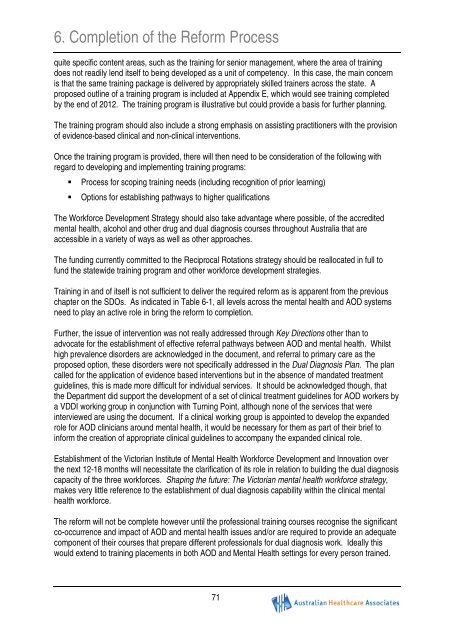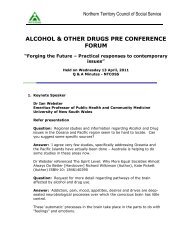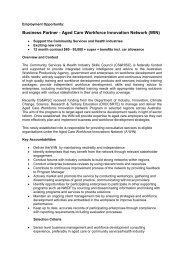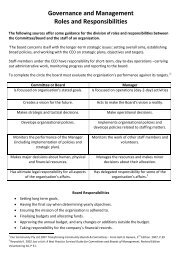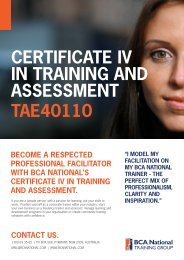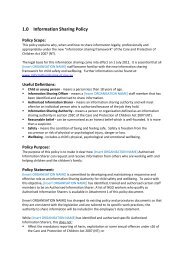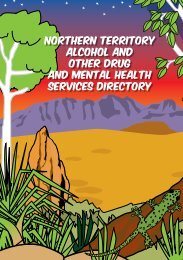(2011) Evaluation of the Victorian Dual Diagnosis Initiative
(2011) Evaluation of the Victorian Dual Diagnosis Initiative
(2011) Evaluation of the Victorian Dual Diagnosis Initiative
You also want an ePaper? Increase the reach of your titles
YUMPU automatically turns print PDFs into web optimized ePapers that Google loves.
6. Completion <strong>of</strong> <strong>the</strong> Reform Process<br />
quite specific content areas, such as <strong>the</strong> training for senior management, where <strong>the</strong> area <strong>of</strong> training<br />
does not readily lend itself to being developed as a unit <strong>of</strong> competency. In this case, <strong>the</strong> main concern<br />
is that <strong>the</strong> same training package is delivered by appropriately skilled trainers across <strong>the</strong> state. A<br />
proposed outline <strong>of</strong> a training program is included at Appendix E, which would see training completed<br />
by <strong>the</strong> end <strong>of</strong> 2012. The training program is illustrative but could provide a basis for fur<strong>the</strong>r planning.<br />
The training program should also include a strong emphasis on assisting practitioners with <strong>the</strong> provision<br />
<strong>of</strong> evidence-based clinical and non-clinical interventions.<br />
Once <strong>the</strong> training program is provided, <strong>the</strong>re will <strong>the</strong>n need to be consideration <strong>of</strong> <strong>the</strong> following with<br />
regard to developing and implementing training programs:<br />
• Process for scoping training needs (including recognition <strong>of</strong> prior learning)<br />
• Options for establishing pathways to higher qualifications<br />
The Workforce Development Strategy should also take advantage where possible, <strong>of</strong> <strong>the</strong> accredited<br />
mental health, alcohol and o<strong>the</strong>r drug and dual diagnosis courses throughout Australia that are<br />
accessible in a variety <strong>of</strong> ways as well as o<strong>the</strong>r approaches.<br />
The funding currently committed to <strong>the</strong> Reciprocal Rotations strategy should be reallocated in full to<br />
fund <strong>the</strong> statewide training program and o<strong>the</strong>r workforce development strategies.<br />
Training in and <strong>of</strong> itself is not sufficient to deliver <strong>the</strong> required reform as is apparent from <strong>the</strong> previous<br />
chapter on <strong>the</strong> SDOs. As indicated in Table 6-1, all levels across <strong>the</strong> mental health and AOD systems<br />
need to play an active role in bring <strong>the</strong> reform to completion.<br />
Fur<strong>the</strong>r, <strong>the</strong> issue <strong>of</strong> intervention was not really addressed through Key Directions o<strong>the</strong>r than to<br />
advocate for <strong>the</strong> establishment <strong>of</strong> effective referral pathways between AOD and mental health. Whilst<br />
high prevalence disorders are acknowledged in <strong>the</strong> document, and referral to primary care as <strong>the</strong><br />
proposed option, <strong>the</strong>se disorders were not specifically addressed in <strong>the</strong> <strong>Dual</strong> <strong>Diagnosis</strong> Plan. The plan<br />
called for <strong>the</strong> application <strong>of</strong> evidence based interventions but in <strong>the</strong> absence <strong>of</strong> mandated treatment<br />
guidelines, this is made more difficult for individual services. It should be acknowledged though, that<br />
<strong>the</strong> Department did support <strong>the</strong> development <strong>of</strong> a set <strong>of</strong> clinical treatment guidelines for AOD workers by<br />
a VDDI working group in conjunction with Turning Point, although none <strong>of</strong> <strong>the</strong> services that were<br />
interviewed are using <strong>the</strong> document. If a clinical working group is appointed to develop <strong>the</strong> expanded<br />
role for AOD clinicians around mental health, it would be necessary for <strong>the</strong>m as part <strong>of</strong> <strong>the</strong>ir brief to<br />
inform <strong>the</strong> creation <strong>of</strong> appropriate clinical guidelines to accompany <strong>the</strong> expanded clinical role.<br />
Establishment <strong>of</strong> <strong>the</strong> <strong>Victorian</strong> Institute <strong>of</strong> Mental Health Workforce Development and Innovation over<br />
<strong>the</strong> next 12-18 months will necessitate <strong>the</strong> clarification <strong>of</strong> its role in relation to building <strong>the</strong> dual diagnosis<br />
capacity <strong>of</strong> <strong>the</strong> three workforces. Shaping <strong>the</strong> future: The <strong>Victorian</strong> mental health workforce strategy,<br />
makes very little reference to <strong>the</strong> establishment <strong>of</strong> dual diagnosis capability within <strong>the</strong> clinical mental<br />
health workforce.<br />
The reform will not be complete however until <strong>the</strong> pr<strong>of</strong>essional training courses recognise <strong>the</strong> significant<br />
co-occurrence and impact <strong>of</strong> AOD and mental health issues and/or are required to provide an adequate<br />
component <strong>of</strong> <strong>the</strong>ir courses that prepare different pr<strong>of</strong>essionals for dual diagnosis work. Ideally this<br />
would extend to training placements in both AOD and Mental Health settings for every person trained.<br />
71


